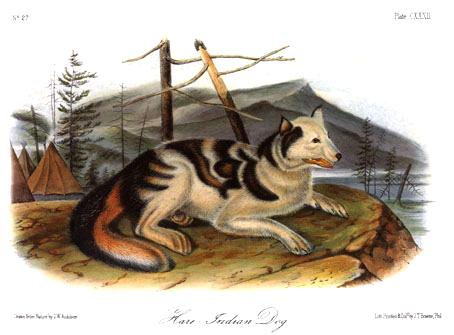

132 Hare Indian Dog
CANIS FAMILIARIS.--LINN. (VAR. LAGOPUS.)
HARE-INDIAN DOG.
[Domestic Dog]
PLATE CXXXII.--MALE.
C. Magnitudine inter lupum et vulpem fulvum intermedius, auriculis erectis,
cauda comosa, colore cinereo, albo nigroque notato.
CHARACTERS.
Intermediate in size between the wolf and red fox; ears, erect; tail,
bushy; colour, gray, varied with white and dark markings.
DESCRIPTION.
The Hare-Indian Dog resembles the wolf rather more than the fox. Its head
is small, muzzle slender, ears erect, eyes somewhat oblique, legs slender, feet
broad and hairy, and its tail bushy and generally curled over its hip. The body
is covered with long hair, particularly about the shoulders. At the roots of
the hair, both on the body and tail, there is a thick wool. On the posterior
parts of the cheeks the hair is long and directed backwards, giving the animal
the appearance of having a ruff around the neck.
COLOUR.
Face, muzzle, belly, and legs, cream white; a white central line passes
over the crown of the head to the occiput; the anterior surface of the ear is
white, the posterior yellowish-gray or fawn colour; tip of nose, eyelashes, roof
of mouth, and part of the gums, black; there is a dark patch over the eye, and
large patches of dark blackish-gray or lead colour, on the body mixed with fawn
colour and white, not definite in form, but running into each other. The tail
is white beneath, and is tipped with white.
DIMENSIONS.
Feet. Inches.
Length of head and body, about . . . . 3 0
Height at shoulder, about. . . . . . 1 2
Length of tail, . . . . . . . . . 1 3
HABITS.
This animal is more domestic than many of the wolf-like Dogs of the plains,
and seems to have been entirely subjugated by the Indians north of the great
lakes, who use it in hunting, but not as a beast for burthen or draught.
Sir JOHN RICHARDSON says (F. B. A., p. 79): "The Hare-Indian Dog is very
playful, has an affectionate disposition, and is soon gained by kindness. It is
not, however, very docile, and dislikes confinement of every kind. It is very
fond of being caressed, rubs its back against the hand like a cat, and soon
makes an acquaintance with a stranger. Like a wild animal it is very mindful of
an injury, nor does it, like a spaniel, crouch under the lash; but if it is
conscious of having deserved punishment, it will hover round the tent of its
master the whole day, without coming within his reach, even if he calls it. Its
howl, when hurt or afraid, is that of the wolf; but when it sees any unusual
object it makes a singular attempt at barking, commencing by a kind of growl,
which is not, however, unpleasant, and ending in a prolonged howl. Its voice is
very much like that of the prairie wolf.
"The larger Dogs which we had for draught at Fort Franklin, and which were
of the mongrel breed in common use at the fur posts, used to pursue the
Hare-Indian Dogs for the purpose of devouring them; but the latter far
outstripped them in speed, and easily made their escape. A young puppy, which I
purchased from the Hare Indians, became greatly attached to me, and when about
seven months old ran on the snow by the side of my sledge for nine hundred
miles, without suffering from fatigue. During this march it frequently of its
own accord carried a small twig or one of my mittens for a mile or two; but
although very gentle in its manners it showed little aptitude in learning any of
the arts which the Newfoundland Dogs so speedily acquire, of fetching and
carrying when ordered. This Dog was killed and eaten by an Indian, on the
Saskatchewan, who pretended that he mistook it for a fox."
The most extraordinary circumstance in this relation is the great endurance
of the puppy, which certainly deserves special notice. Even the oldest and
strongest Dogs are generally incapable of so long a journey as nine hundred
miles (with probably but little food), without suffering from fatigue.
GEOGRAPHICAL DISTRIBUTION.
It is stated by Sir JOHN RICHARDSON that this species exists only among the
different tribes of Indians that frequent the borders of Great Bear lake and the
Mackenzie river.
GENERAL REMARKS.
From the size of this animal it might be supposed by those who are desirous
of tracing all the Dogs to some neighbouring wolf, hyena, jackal, or fox, that
it had its origin either from the prairie wolf or the red fox, or a mixture of
both.
The fact, however, that these wolves and foxes never associate with each
other in the same vicinity, and never have produced an intermediate variety, or,
that we are aware of, have ever produced a hybrid in their wild state, and more
especially the fact that the prairie wolf, as stated by RICHARDSON, does not
exist within hundreds of miles of the region where this Dog is bred, must lead
us to look to some other source for its origin.
Its habits, the manner in which it carries its tail, its colour, and its
bark, all differ widely from those of the prairie wolf.
We have never had an opportunity of seeing this animal and examining it,
except in the stuffed specimen from which our drawing was made; we are therefore
indebted to Sir JOHN RICHARDSON for all the information we possess in regard to
its habits, and have in this article given the results of his investigations
mostly in his own language.
|